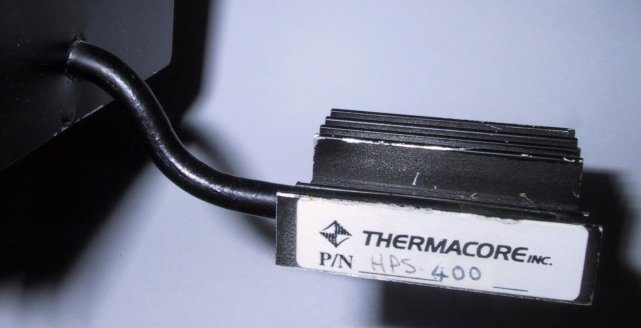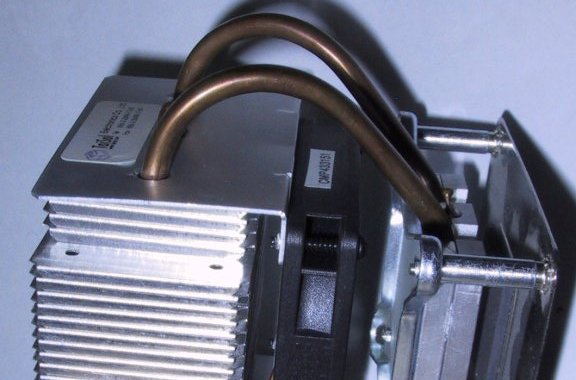THE HEATSINK GUIDE: Heat pipe information
Introduction
The days where heat pipes were mostly used for temperature equalization in spacecrafts and satellites are over. Nowadays,
we commonly find heat pipes in notebook computers, game consoles, and even integrated into normal PC CPU coolers. One
reason for the rise in popularity is the fact that prices have dropped dramatically, since high-volume cooling product manufacturers
like Asia Vital Components now have their own heat pipe manufacturing facilities, and heat pipe manufacturing is no longer
reserved to a few specialized companies.
When it comes to PC cooling, "heat pipe" has become a buzzword; but still, few people understand how heat pipes work, and what factors
must be considered when using a heat pipe-based cooling system. This article should provide some clarifications.
What are heat pipes?
A heat pipe is a device has an extremely high thermal conductivity, and is used to transport heat. In order to achieve this,
heat pipes take advantage of simple physical effects:
As a liquid evaporates, energy - in the form of heat - must be taken from the environment. Therefore, an evaporating liquid
will cool the surrounding area. This is how a heat pipe effectively cools the heat source. However, this doesn't get rid
of the heat; heat is just transported with the vapor. At the target side for heat transport, the heat pipe must be cooled, for
example using a heatsink. Here, the inverse effect takes place: The liquid condenses, and therefore emits heat.
Using
these effects, it is possible to build heat pipes that have a thermal conductivity that is many thousand times higher
than a copper piece of the same size. Note that unlike Peltier elements, a heat pipe does
not consume energy or produce heat itself. It is also not possible to cool a device below ambient temperature using a heat pipe.

Heat pipe made by Thermacore
Design of heat pipes, and heat pipe related problems
Sounds great? Sure, but there are a few things to consider. In order to understand heat pipe-related problems, we will look
at a simple model heat pipe, which is actually more of a thermosyphon.
Following the explanations in the above paragraph, you can imagine a simple device: A
closed metal tube in vertical orientation, filled with a small amount of water, and a heatsink mounted on its upper side.
If you apply a heat source to the lower side, the water will evaporate, while cooling the heat source. The vapor will move up,
and condense near the heatsink on top. From there, water will drip back to to the bottom, evaporate again, etc.
This simple model already shows the common problems related to heat pipe technology:
-
At normal atmospheric pressure, this would allow the heat pipe to keep the heat source at a temperature of around 100 degress Celsius, the temperature at which water evaporates.
However, since heat pipes are tightly sealed tubes, the exact evaporation temperature can be further adjusted to a certain extent by varying the pressure inside the tube (usually reducing it).
To cover other temperature ranges, heat pipe manufacturers use various working fluids instead of water, to cover a very wide range
of temperatures.
One problem stays: A heat pipe designed for a certain temperature range will only work well in this
range; designing a universal heat pipe for all temperature ranges is not possible.
Apart from the vapour temperature range, factors like thermal stability and thermal conductivity influence the choice
of working fluid.
Suitable working fluids include:
- For ultra low temperatures: inert gases (helium), nitrogen, ammonia
- For usual temperatures to meet electronics cooling requirements: Distilled water with various additions, organic substances like acetone (think nailpolish remover),
methanol, ethanol (think booze), toluene (think magic markers).
- For high temperatures: Metals like mercury, sodium, silver.
- Vertical orientation required - In our simple model heat pipe, the working fluid simply drips back to the heat source.
It is quite obvious that this design will only work in vertical orientation. To overcome this limitation, commercially
available heat pipes do not rely on gravity alone to move the liquid back to the heat source; they take advantage of capillary action.
The inside of the heat pipe tube is filled with a capillary structure, often referred to as wick.
Different structures are being used:
- The most simple structure is a grooved tube. Here, capillary action merely helps gravity; vertical orientation
of the heat pipe is usually still required.
- Most commonly used, due to better capillary action, is a multilayered metal mesh.
- Sintered powder capillar structures allow the stronges capillar action, but are more expensive to manufacture. Even
with this design, performance of the heat pipe still depends on the orientation, and upside-down operation usually still isn't possible.
Not only the wick itself influences the strength of the capillary action, but also the choice of working fluid. A high surface
tension of the working fluid improves performance.
- Poor behaviour in case of overheating - if the heat source is too strong, and the heat pipe is heated beyond
its specified temperature, it may happen that no condensation occurs anymore, and the entire working "fluid" inside the
heat pipe is in vapour form. In this situation, the heat pipe's ability to transport heat collapses. This is a danger
to consider when relying on heat pipes for cooling sensitive elements.
Usage of heat pipes
Given the excellent thermal conductivity of heat pipes, there are two situations in which heat pipes are particularly suitable:
- In restricted space environments - in notebook computers, game consoles, home theater PCs, it is a common situation
that due to space restrictions, it is not possible to mount a heatsink directly at the place where the heat is produced (that is, on the CPU). Here,
a heat pipe can lead heat to a place where more space for a heatsink is available.
- To improve thermal transfer within a heatsink. Heat pipes can be used in heatsink design to improve performance,
by optimizing thermal conduction within the heatsink construction. This way, heat is more efficiently transported away from the
contact area with the CPU, to the outer parts of the heatsink where cooling occurs. However, there have been PC coolers where
it seems that the usage of a heat pipe was more of a marketing argument than a technical necessity. Heat pipes used in PC CPU
coolers are usually inexpensive units with low capillary action. Considering this, the usage of a heat pipe on the CPU cooler,
especially when installed in a tower case (vertical orientation of the heat pipe), is rather questionable.

Unusual heatpipe-based cooler from Taisol (detail view):
In this design, the fan is located between CPU and heatsink, and blows air away
from the CPU, through the heatsink. Thermal transfer from CPU to heatsink
is done by heat pipes.
Conclusion
When used properly, heat pipes can do wonders. However, they are certainly not the ultimate solution to all cooling related
problems. Due to the number of factors to consider when applying heat pipes, my advice is: Use ready-made heatpipe-based
coolers only if you are absolutely sure that they are suitable for your particular cooling problem. Do not try to build your own heatpipe-based
cooling system, unless you really know what you are doing.
If you found this article not technical enough, and missed details and in-depth information, please visit http://www.cheresources.com/htpipes.shtml. In this
excellent article, you will find a more scientific approach to heat pipe technology.
All pages copyright © 1997-2010 Tillmann Steinbrecher
Legal information / Disclaimer / Impressum


